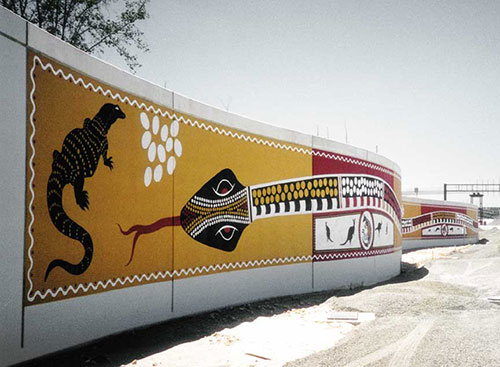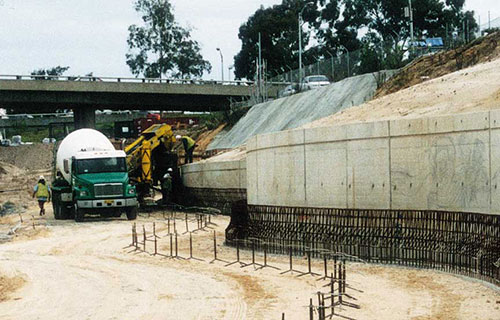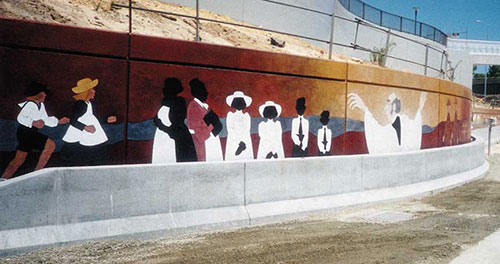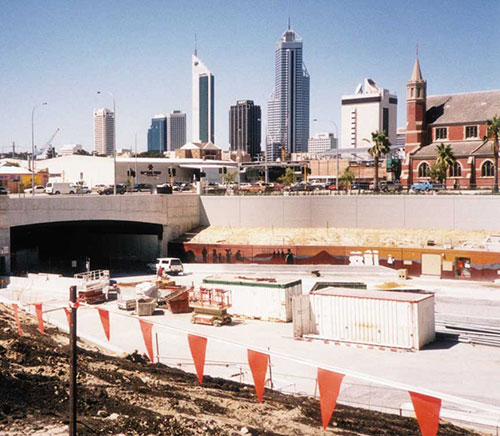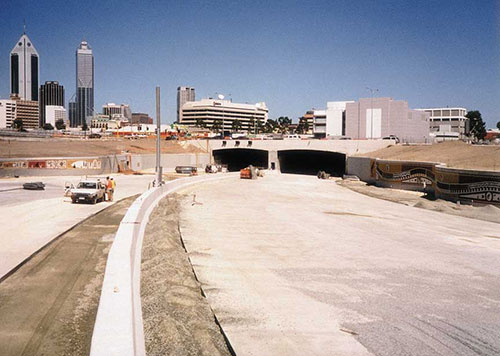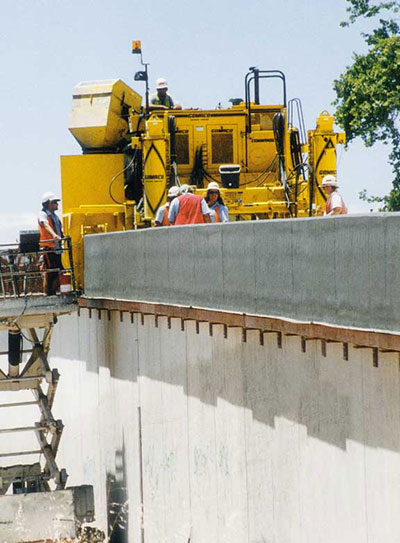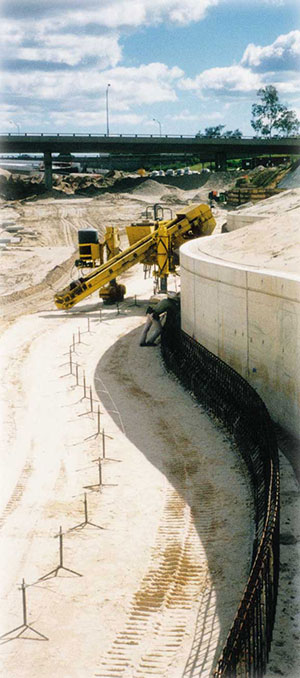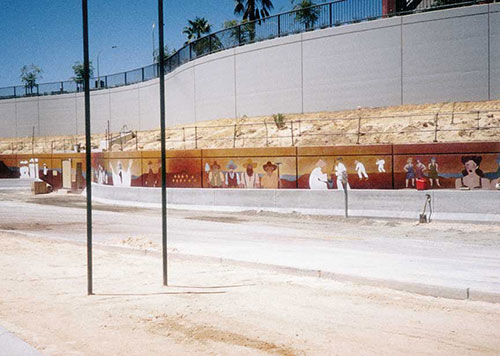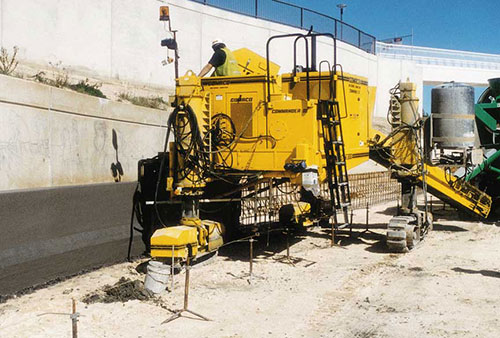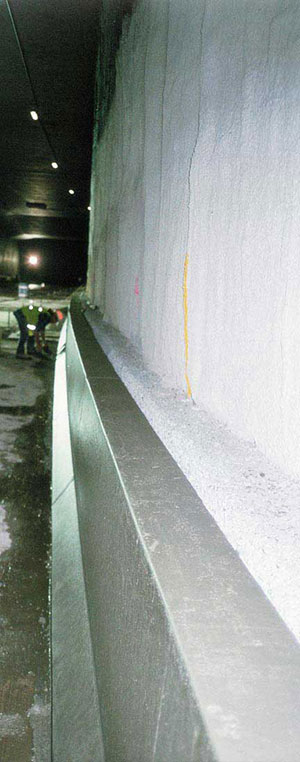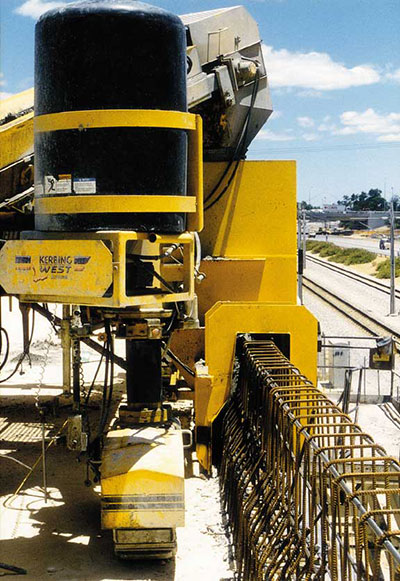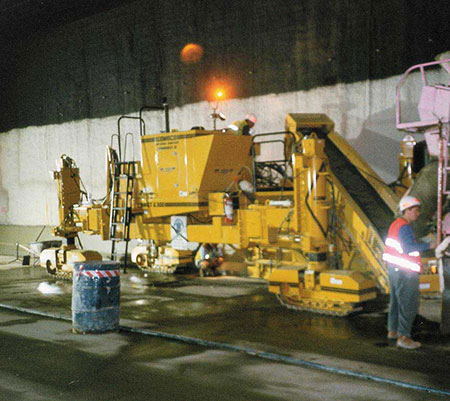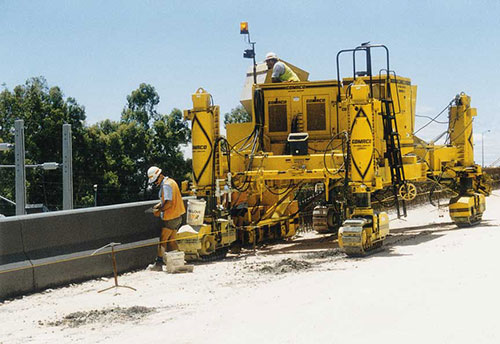GOMACO World Index --- GOMACO World 28.2 - August 2000
A Tale Of Two Coasts - Part 1
Read About Meltreach Proprietary Limited's Barrier Project In Part 2
It's a tale of two coasts on the continent of Australia. The development of the country, as far as population and industrialization, has created two different levels of acceptance for the slipform method. Two contractors on opposite ends of the country are slipforming barrier with their Commander IIIs.
On the west coast, the idea is still new and one contractor is working hard to get the method accepted by the authorities. Kerbing West Slipform, based out of Malaga, Western Australia, slipformed their first barrier in June 1999.
The east coast has had slipforming for over twenty years and is generally accepting of the slipform paving method. Meltreach Proprietary Limited, is based out of Brisbane, Queensland, on the eastern coast.
Despite the two different levels of acceptance, both contractors are still working in the shadow of precast barrier. The Australian Roads Authority demands a superior quality barrier and the GOMACO Commander III is helping the contractors achieve that quality.
Kerbing West's Wagyl Wall
The Graham Farmer Freeway in Perth, Western Australia, has attracted a lot of attention. The project is featuring several firsts for the state and the GOMACO Commander III is playing a part in its development.
The $263 million project was broken down into two stages for construction. When it was completed, Western Australia had a new tunnel, several new roadways, bridges and other transportation improvements.
Kerbing West Slipform, based out of Malaga, was responsible for the barrier inside the tunnel and associated approach road safety barrier. Project specs called for the different types of wall to be handformed during the course of the project. Kerbing West had other ideas on how to form the wall.
"I'd been looking through some magazines and doing some research on slipform pavers for almost two years. When this project came up, I grabbed all the information out again and thought, we could do that," Graham O'Neil, general manager, said. "I went to a friend of mine who's got the Internet and we logged onto the GOMACO Web site (www.gomaco.com) and it all started from there."
Kerbing West was contacted by Paul McLarnon, GOMACO International sales manager and service technician for Australia.
"GOMACO was the only slipform manufacturer to have a representative in Australia and that was important to us," Brian Kennewell, director for Kerbing West, said. "When we bought the Commander III, we were the only company in Western Australia to own a slipforming machine so we had nobody to look over the fence at, if you know what I mean."
The next step was convincing project officials that slipforming was better than handforming the walls.
"It was quite difficult to convince the officials," Kennewell said. "Fortunately, we were able to show them the benefits of slipforming and that it is considerably cheaper and a lot quicker than handforming."
Kerbing West slipformed the four different types of perimeter wall, bridge parapet, and barrier with a Commander III.
"It was a great, nerve-wracking experience," Kennewell said. "It was a bit scary to begin with because the tunnel was the major project in Western Australia at the time. Everybody was looking over our shoulders and I mean everybody. They all wanted to see what this new machine called a slipformer could do."
Things didn't go too smoothly to begin with either. The slipforming process is so new to Western Australia, and concrete suppliers couldn't provide the proper mix.
"It was our first job and we were not only learning, we were confronted with everybody around us learning as well," Kennewell said. "It was a first time for everybody, the concrete supplier, the client, everybody. It was a big learning curve."
Once the proper mix design was developed, the project went smoothly. A 4641 psi (32 MPa) concrete with fiber mix was used for the different types of wall. Slump was approximately one inch (25 mm). Three finishers worked behind the machine.
"We're living in this shadow of the precast era so we have to produce a product which is as close as we can get it to what they call a Class Two finish relating to precast," Kennewell said. "There are engineers that expect the slipform to have the nice smooth finish that precast does. They don't take into consideration that, overall, the slipform product is stronger and has better alignment."
Kerbing West began the project by slipforming the more challenging outer barrier walls of the tunnel. The wall was a challenge because it had to be slipformed up against a no-fines concrete base.
"The no-fines portion is a mixture of blue metal and cement aggregates about eight inches (200 mm) thick which was porous to allow seepage to the drainage section of the tunnel," Kennewell said. "That was quite a bit more difficult than just slipforming barrier against the tunnel wall."
The barrier width was 11.4 inches (290 mm) on the bottom and four inches (105 mm) on top. The barrier was 38 inches (965 mm) tall.
Next, they slipformed the inner barrier walls of the tunnel. The inner barrier wall was 38 inches (965 mm) tall, eight inches (205 mm) and 15.4 inches (390 mm) wide at the top and bottom.
"The surveyors gave us a reading every 16.4 feet (five meters) so we could set our line. We couldn't set levels off the roof or the floor because of the variations in both," Kennewell said. "We were able to use the variable sideplates to make up the difference."
With the tunnel wall complete, Kerbing West started on the bridge parapet sections of the project. The bridge parapet was slipformed over a reinforcing steel cage.
It was slipformed 42.5 inches (1080 mm) tall, 15 inches (380 mm) and 22 inches (555 mm) wide at the top and bottom. The parapet overhang on the back side was eight inches (200 mm). It was laid on a soffit with the soffit supported by brackets at the rear of the barrier base.
The final phase of the barrier project called for the slipforming of free-standing barrier leading into and out of the tunnel on both ends. The designer of the wall drew it in a curvy manner.
"Our Aboriginal heritage has a mythological creature called the wagyl, a river serpent," Kennewell said. "The designer drew the retaining wall in a wriggly manner like a snake so we nicknamed that particular section the wagyl wall, being the serpent wall."
The wagyl wall proved to be a challenge because of the tight radii and steel reinforcing on the wall. Kerbing West had to transform their Commander III from a four-track machine into a three-track one. They also had to cut the mold shroud back 3.3 feet (one meter) to allow a cover of two inches (50 mm) for the radii.
"It was like trying to get a long truck in a tight corner and you run over the curb on the inside corner," Kennewell said. "When you have that reinforcement there and the radius is too tight, it actually hits one side of the front and back of the mold. That's why we cut back the front shroud, to keep it from hitting.
"Credit must go to supervisor Mark Walker, his assistant Craig Kennewell, and workshop manager Keith Quinn for pioneering the Commander III and overcoming the daunting experience of being confronted with an industry totally new to them and coming out on top of every challenge," Kennewell added. "Their knowledge and common sense in the kerbing industry got us through."
The first-time slipformers and owners of the only slipform machine in Western Australia had advice to pass along to others.
"The Commander III will do everything we were told it will do, it probably does a little bit more," Kennewell said. "The emphasis has to be on the mix and I can't stress that more to anybody thinking of purchasing a machine."
The success of Kerbing West's first project is leading to more work and several inquiries about the capabilities of slipforming.
"We've still got a big job ahead of us as far as marketing goes, simply because slipforming is new to Western Australia," Kennewell said. "We're still introducing, showing, and making believers of it and it's already starting to happen. We're getting inquiries on slipform paving and there's work around the corner."
Kerbing West is negotiating for a bridge project on the Narrows Bridge over the Swan River and approximately 11,483 feet (3500 m) of bus-line barrier. They also intend on promoting the paving side of their four-track Commander III to create additional business.
"We're very happy with the Commander III and it's really quite a good machine," Kennewell said. "We're also really impressed with Paul McLarnon. His service has been excellent and his help has been really good. That's important when you're 3107 miles (5000 km) away from the nearest slipformer."
Subscribe to Receive GOMACO World Magazine
